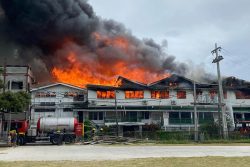One of the realities of modern life is the amount of time we spend waiting – for the telephone technician to come; for the traffic jam ahead of you to clear; for the part you ordered from overseas to arrive, and, particularly taxing for me, the amount of time we spend in various customer lines or waiting-rooms. One saving grace in the latter category can be the amount of reading matter thoughtfully provided for us so that, just recently, I was fascinated by a magazine feature on the drone technology that is now surging around us, full speed ahead.
As waiting-room magazines usually are, this one was old – June 2014 – but for a non-techno like me the article was a revelation. Just from skimming the Popular Mechanics article, I learned that these frail-looking devices can actually lift considerable weight – as in the quite heavy cameras used in making movies – but can also be small enough to land in the palm of your hand, and that even after a midair rotor loss they can stay aloft for several minutes and remain stable. The drones’ ability to keep a camera steady as it manoeuvres up or down, forward or back, is remarkable, and the list of applications for the device is constantly being expanded.
 Not two days after skimming the 2014 article, I was present at the launch of a University of Guyana (UG) seminar on our Entrepreneurship and Business Innovation at which Guyana’s Drones Operation Officer, Captain Christine Marcus, touched on the transformative effect this technology will have for Guyana. Captain Marcus, who showed keen interest in technology at a young age, had become a qualified pilot in 2009 in New York and went on to study air-frame and general aircraft issues which interested her.
Not two days after skimming the 2014 article, I was present at the launch of a University of Guyana (UG) seminar on our Entrepreneurship and Business Innovation at which Guyana’s Drones Operation Officer, Captain Christine Marcus, touched on the transformative effect this technology will have for Guyana. Captain Marcus, who showed keen interest in technology at a young age, had become a qualified pilot in 2009 in New York and went on to study air-frame and general aircraft issues which interested her.
In her address at the UG Seminar she stressed that “Our Unmanned Aerial Vehicles (UAV) or Drones are powerful tools that reinforce the importance of why embracing this device in this innovative technological age will be socially and economically beneficial for Guyana” and she cited the example of Rwanda where it has transformed that country’s childbirth mortality rate by getting medical supplies to patients in 15 minutes, by drones, as opposed to 4 hours overland; a situation which parallels our own interior experience. She said: “Due to the creative innovative minds of a few social entrepreneurs, this drone device is playing a vital role in helping to reduce maternal deaths, a quarter of which are the direct result of blood loss during childbirth. Traditionally, in Guyana, in our Amerindian communities, pregnant women are reluctant to go to doctors until the very end when they come to town to deliver.”
Another use is in the livestock industry where some operators have become interested in using drones to look for their cattle, straying over into Brazil, etc. and one company is using drones to gather data on the proposed road to Lethem with regard to the impact on the environment and on the likelihood of the washing away of the road bed. She said the company will provide government with the results of this study.
Captain Marcus added: “In Guyana’s agricultural sector which accounts for approximately one-third of our GDP, drones have the potential to transform that industry by replacing functions served by satellites, manned aircraft, ground machinery, and manual labour. Also, data gathered by drones can increase productivity by allowing for the optimal application of such things as fertilizers and pesticides. Such uses will create opportunities for innovative producers.”
President of the Guyana Marine Conservation Society, Annette Arjoon-Martins, who has had extensive involvement with conservation issues, lauds the work Captain Marcus’ unit is doing in structuring this emerging drone technology. “It is a revelation what these units can do for us. Although, for example, I worked for 25 years at Shell Beach and was therefore aware of the wetland stretches behind it, I was astounded by the views we got from drones flying over the area. To see the various activities of nature taking place there was a revelation; without the drone we would never had that perspective.”
Captain Marcus pointed to other observation capabilities of the drone in sectors such as mining where the degree of environmental damage can be easily assessed as opposed to the tedious and personnel-intensive examination on the ground.
She cites the advantage to medical personnel, for example, being able to access emergency supplies quickly, as in malaria outbreaks. “In that situation, it can make a difference between life and death. Without the drone, you have to wait on the boat to come in, or the plane from Georgetown, with the medicines. The time difference is significant. When you start to see the human side it can affect, it is important that we take advantage of this technology and regulate it properly because for a country like Guyana, and the African countries, with similar extensive remote areas, this is a boon.”
Among the sectors in Guyana using drones, she feels that agriculture will benefit the most. “In that field, this technology can really be an asset. When you have the ability to reach the crops close up, as the drones can, you’re not going to waste fertilizer or pesticide. Also, you’re using less manpower and you can cover more territory more quickly.”
On the purely administrative side of her work, she said: “The Civil Aviation Authority is interacting with the various groups, so we meet with the drone operators, the air traffic control officials, the business people, etc., to learn what are their priorities, what are they concerns, what are their proposals, and we use that information to tailor the regulations accordingly.”
On the matter of regulation for drones, Captain Marcus said, “The regulation aspect is a careful one and it can therefore be a long process; we have to meet ICAO (International Civil Aviation Organization) approval. As an agency, we realized very early that we had to change our regulatory approach in order to safely integrate the new technology without stifling innovation, so that’s the course we’re on.”
The Drones Operation Officer is very upbeat about the way ahead. “This is a new technology for Guyana and it is the future, so we have approached integration in a spirit of flexibility, partnership and collaboration. We are implementing regulations that are flexible enough to support our policies and are also in harmony with economic development of Guyana.”









